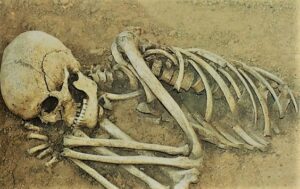
Who were the people of the Harappan civilization? J. G. Saffer and D. A. According to Lichtenstein, the people of the Harappan civilization are an amalgamation of Bagor, Hakra and Koti Diz communities of the Ghalpar-Hakra valley on the India-Pakistan border. But at the beginning of this thought, is a skeleton from Rakhigari in Haryana going to kill Kurul. Its archaeological identity around the world as I 4411.
For the past decade and a half, Rakhigari’s name has been circulating in school textbooks, tourism department leaflets and journalists’ columns. Rakhigari is the largest excavation site of Harappan civilization. Which is located in India. In 2014, it was reported that this Rakhigari is much bigger than Mohenjodaro, which was discovered in Sindh in Pakistan in 1920.
However, excavation work at Rakhigarh started much later, from 1960s onwards. Archaeologists discovered that this civilization dates back to 7000 years before the birth of Jesus Christ. 4000 years ago this civilization reached the peak of excellence and suddenly mysteriously collapsed. This Horplii was the first Indian Urban Civilization.
Is the DNA report on the petrous bones of a 4,500-year-old skeleton found 22 meters below the ruins of the Harappan civilization at Haryana’s Rakhigarh going to yield some sensational historical information? Which will shake India and India’s history if it is officially published? India’s history will take a historic turn, which was the past imagination? Recently an all-India paper had the headline, ‘Harappan ruins Rakhigari. DNA tests show no traces of Central Asia. Arya’s rejection of aggression?
The much-awaited results of DNA from the skull of a 4500-year-old Harappan man have not been officially released, but some have leaked. DNA tests have found no Central Asian links to the Harappan civilization. So, the Aryan invasion theory of Harappan civilization is going to fail. Because the most sensational finding in DNA testing is the complete absence of the genetic marker Arya or Arya gene in the DNA of Harappa man.
The gene called Arya was found among the Copper Age people whose homeland was the Pontic steppe grasslands of Central Asia. It is located between the Black Sea and the Caspian Sea. Who spread out about 4000 years ago. Their genetic traits dictated that they were industrious, stoutly built and patriarchal. It was they who brought about the linguistic (Indo-European) union of Northern India with Northern Europe. However, historians have already said that the Aryan people or Aryans did not have any contribution in the construction of Harappan civilization.
Sarvabharatiya newspaper quoted a scientist researching this topic. He is Dr. Basant Sindhe of Deccan College, Pune, the team leader of the Rakhigari DNA Project. Dr. Sindhe said, “The Harappan DNA of Rakhigari proves that it is completely local DNA. A ubiquitous presence of mitochondrial DNA was noted. However, very few features are found, which are not local features. Yet it is clear to us beyond doubt that it is the DNA of the local people.
Sindhe also said, “This DNA archeologically proves that the Aryans did not establish the Harappan civilization.” Indigenous people did. We did not discuss Arya in this project, said Neeraj Rai, one of the researchers of the Rakhigari DNA project. Because Arya was not found in DNA. Rakhigari DNA data revealed that I-4411 is a male. But it was precisely from Central Asia that a large population moved in different directions. The genes of that group also influenced the genes of various groups of people in South Asia.
But that imprint did not fall on the people of the Harappan civilization and we humans of India carry only 17.5 percent Pontic steppe genetic traits. Archaeologist Neeraj Rai gave another startling information. When asked about the identity of our 4,500-year-old ancestor, Niraj Rai’s short answer was, ‘The closest relation to I-4411 has been found in the Irula tribes of the Nilgiri Mountains of South India. Perhaps the Harappans spoke a proto-Dravidian language.’
We knew that India had a highly advanced civilization thousands of years before the Aryans came to India. That civilization was developed by the Bagor, Hakra and Koti Diz communities living in the northern part of India at that time. The civilization that became a symbol of human valor, virility and development in South Asia 2000 years before the birth of Jesus Christ. Whose is the Indus civilization? The question arose, the history of world-class historians who have been mistaken for so long?
Sarvabharatiya newspaper wrote, if Rakhigari DNA was asked as a human being, these answers would have been found.
Question: Harappan civilization is the birth of Sanskrit and Vedic Hinduism?
Answer of Rakhigari DNA: No.
Question: Are the genes of the people of the Harappan civilization similar to those of the present day Indians?
Rakhigari DNA Answer: Yes of course.
Q: According to popular belief the Aryans were closely related to the Harappan people. They were also Aryans. But what does Rakhigari DNA say? Rakhigari DNA Answer: There is no evidence of any genetic relationship between the Aryans and the Harappan people. Very close relationship with Dravidian people.
Question: Are there any genetic similarities between Harappan people and North or South Indian people? Rakhigari DNA Answer: South Indian.
Is this recent sensational study going to spark intense debate across religious, political and geographical contexts across India? Indian history and history in India is going to turn the tide? The Dravidian Harappan-man of South Indian genes is about to strike the final blow even after so long self-flagellation over the outstanding contribution of North India to the rise of Indian civilization. Just waiting for the official release of the Rakhigari DNA project report.

Leave a Reply
You must be logged in to post a comment.